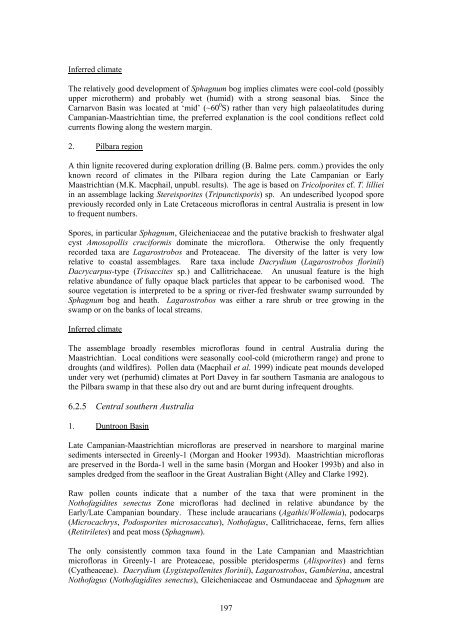OFR 151.pdf - CRC LEME
OFR 151.pdf - CRC LEME
OFR 151.pdf - CRC LEME
You also want an ePaper? Increase the reach of your titles
YUMPU automatically turns print PDFs into web optimized ePapers that Google loves.
Inferred climate<br />
The relatively good development of Sphagnum bog implies climates were cool-cold (possibly<br />
upper microtherm) and probably wet (humid) with a strong seasonal bias. Since the<br />
Carnarvon Basin was located at ‘mid’ (~60 0 S) rather than very high palaeolatitudes during<br />
Campanian-Maastrichtian time, the preferred explanation is the cool conditions reflect cold<br />
currents flowing along the western margin.<br />
2. Pilbara region<br />
A thin lignite recovered during exploration drilling (B. Balme pers. comm.) provides the only<br />
known record of climates in the Pilbara region during the Late Campanian or Early<br />
Maastrichtian (M.K. Macphail, unpubl. results). The age is based on Tricolporites cf. T. lilliei<br />
in an assemblage lacking Stereisporites (Tripunctisporis) sp. An undescribed lycopod spore<br />
previously recorded only in Late Cretaceous microfloras in central Australia is present in low<br />
to frequent numbers.<br />
Spores, in particular Sphagnum, Gleicheniaceae and the putative brackish to freshwater algal<br />
cyst Amosopollis cruciformis dominate the microflora. Otherwise the only frequently<br />
recorded taxa are Lagarostrobos and Proteaceae. The diversity of the latter is very low<br />
relative to coastal assemblages. Rare taxa include Dacrydium (Lagarostrobos florinii)<br />
Dacrycarpus-type (Trisaccites sp.) and Callitrichaceae. An unusual feature is the high<br />
relative abundance of fully opaque black particles that appear to be carbonised wood. The<br />
source vegetation is interpreted to be a spring or river-fed freshwater swamp surrounded by<br />
Sphagnum bog and heath. Lagarostrobos was either a rare shrub or tree growing in the<br />
swamp or on the banks of local streams.<br />
Inferred climate<br />
The assemblage broadly resembles microfloras found in central Australia during the<br />
Maastrichtian. Local conditions were seasonally cool-cold (microtherm range) and prone to<br />
droughts (and wildfires). Pollen data (Macphail et al. 1999) indicate peat mounds developed<br />
under very wet (perhumid) climates at Port Davey in far southern Tasmania are analogous to<br />
the Pilbara swamp in that these also dry out and are burnt during infrequent droughts.<br />
6.2.5 Central southern Australia<br />
1. Duntroon Basin<br />
Late Campanian-Maastrichtian microfloras are preserved in nearshore to marginal marine<br />
sediments intersected in Greenly-1 (Morgan and Hooker 1993d). Maastrichtian microfloras<br />
are preserved in the Borda-1 well in the same basin (Morgan and Hooker 1993b) and also in<br />
samples dredged from the seafloor in the Great Australian Bight (Alley and Clarke 1992).<br />
Raw pollen counts indicate that a number of the taxa that were prominent in the<br />
Nothofagidites senectus Zone microfloras had declined in relative abundance by the<br />
Early/Late Campanian boundary. These include araucarians (Agathis/Wollemia), podocarps<br />
(Microcachrys, Podosporites microsaccatus), Nothofagus, Callitrichaceae, ferns, fern allies<br />
(Retitriletes) and peat moss (Sphagnum).<br />
The only consistently common taxa found in the Late Campanian and Maastrichtian<br />
microfloras in Greenly-1 are Proteaceae, possible pteridosperms (Alisporites) and ferns<br />
(Cyatheaceae). Dacrydium (Lygistepollenites florinii), Lagarostrobos, Gambierina, ancestral<br />
Nothofagus (Nothofagidites senectus), Gleicheniaceae and Osmundaceae and Sphagnum are<br />
197

















